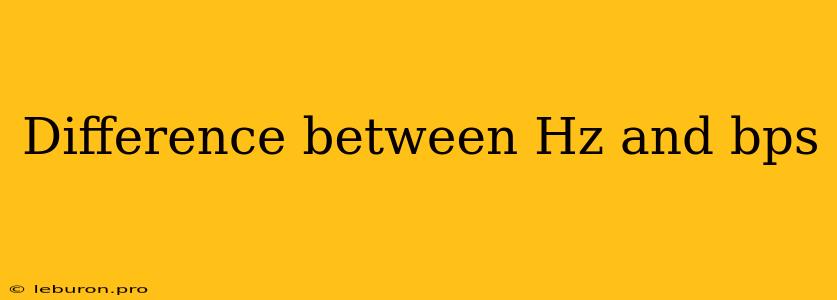Understanding the difference between Hertz (Hz) and bits per second (bps) is crucial for anyone navigating the world of technology and data transfer. Both units are fundamental in describing aspects of data transmission, but they measure distinct characteristics. Hertz refers to the frequency of a signal, while bits per second quantifies the rate at which data is transferred. This article will delve into the intricacies of these units, exploring their individual meanings, applications, and the crucial distinction between them.
Hertz (Hz): The Frequency of Data Transmission
Hertz is a unit of measurement that indicates the frequency of a signal. In simpler terms, it describes how many cycles of a wave occur per second. A wave cycle represents a complete oscillation, going from a peak to a trough and back to the peak. This concept is particularly relevant in the context of data transmission because signals, whether they are radio waves, electrical signals, or light pulses, are used to carry data.
Frequency plays a vital role in determining the speed and capacity of data transmission. Higher frequencies allow for the transmission of more data within a given timeframe. This is because a higher frequency wave has more cycles per second, which means it can carry more data per cycle.
Here are some examples of how Hertz is used in technology:
- Radio waves: The frequency of radio waves determines which radio station you can tune into. AM radio operates at lower frequencies, while FM radio uses higher frequencies.
- Computer processors: The speed of a computer processor is measured in Gigahertz (GHz), which is billions of Hertz. This indicates how many operations the processor can perform per second.
- Data networks: The speed of a network connection is sometimes described in terms of the frequency band it operates on. For instance, 5G networks use a higher frequency range than 4G networks.
Understanding the Significance of Hz in Data Transmission
The frequency of a signal directly impacts the amount of data that can be transmitted within a certain time frame. Higher frequencies generally lead to faster data transmission speeds. However, it's essential to understand that frequency alone doesn't guarantee higher bandwidth. Bandwidth, the actual data transmission rate, is influenced by other factors, including the modulation technique and the physical properties of the transmission medium.
Bits per Second (bps): The Rate of Data Transfer
Bits per second (bps) measures the amount of data transferred in one second. This is the true indicator of data transmission speed. One bit is the smallest unit of data, representing a binary digit, either 0 or 1. Therefore, bps tells us how many bits are transmitted each second.
Here are some examples of data transfer rates measured in bps:
- Internet connection: Your internet service provider (ISP) will usually advertise your internet speed in Mbps (megabits per second), which is millions of bits per second.
- Hard drive speeds: The transfer rate of a hard drive is often measured in MBps (megabytes per second), which is millions of bytes per second. One byte is equal to 8 bits.
- USB transfer rates: The speed of a USB connection is also measured in Mbps or GBps (gigabytes per second).
Delving Deeper into bps and its Relevance
The higher the bps, the faster the data transfer rate. This is essential for various applications, such as downloading large files, streaming high-definition videos, and playing online games. Higher bps values equate to faster loading times, smoother streaming experiences, and more efficient data transmission.
The Fundamental Distinction Between Hz and bps
While both Hz and bps are crucial in the realm of data transmission, they measure distinct aspects:
- Hz measures the frequency of a signal, which is the number of cycles per second.
- bps measures the rate of data transfer, which is the number of bits transmitted per second.
Think of it this way: frequency is like the pace of a drummer, while the data transfer rate is like the amount of information the drummer is able to convey per beat. A faster drummer (higher frequency) can convey more information per beat (higher data transfer rate).
Practical Applications and Real-world Scenarios
Understanding the difference between Hz and bps is vital for making informed decisions when it comes to technology and data transfer. Here are some real-world scenarios:
- Choosing a Wi-Fi router: When selecting a Wi-Fi router, you'll often see specifications mentioning both frequency bands and data transfer rates. A dual-band router might offer 2.4 GHz and 5 GHz bands, with different data transfer rates for each band.
- Purchasing a computer: The clock speed of a computer processor is measured in GHz (gigahertz). A higher clock speed indicates a faster processor, capable of handling more operations per second.
- Streaming services: Streaming services often advertise their bitrates in Mbps, indicating the quality and smoothness of the video stream. Higher bitrates result in higher quality video, but they also require a faster internet connection.
Conclusion
Hz and bps are both essential concepts in data transmission, but they measure different aspects of the process. Hz measures the frequency of a signal, which is the number of cycles per second, while bps measures the rate of data transfer, which is the number of bits transmitted per second. Understanding this distinction is vital for making informed decisions regarding technology and data transfer. By grasping the relationship between these two units, you can navigate the digital world with greater confidence and efficiency.
